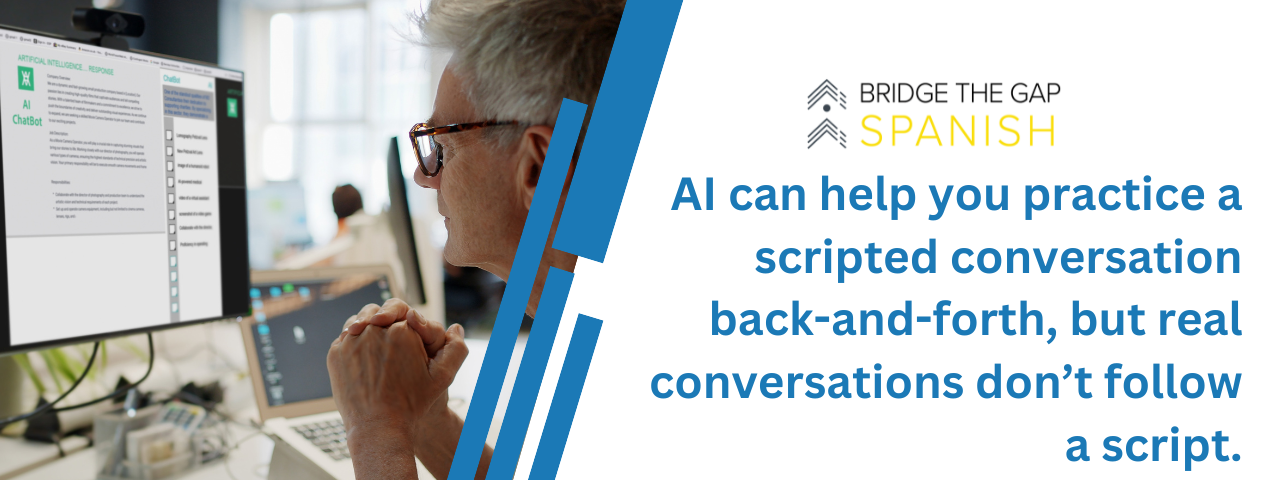Artificial intelligence is shaking things up, everywhere— from diagnosing health problems to generating art, writing code, and yes, even teaching languages, like Spanish.
-
With chatbots, language learning apps, and speech recognition technology, you can practice Spanish anytime, day or night.
-
A good AI Spanish tutor can drill you on grammar rules, explain confusing phrases, and even help with pronunciation. So that’s a win.
But here’s the thing.
Real-life Spanish isn’t scripted. People talk fast, jump topics, use slang, and get emotional. Learning a language means keeping up with that, not just memorizing words.
AI can support the journey, but it still can’t teach you how to connect with people, culture, and meaning.
In this post, we’ll break down:
-
What Spanish AI tools do well
-
Where AI falls short
-
Why human interaction is still a must if you want to speak Spanish in the real world.
And if you’re looking for both structure and real conversation practice, we’ll show you how Bridge the Gap Spanish brings it all together.
What AI Can Teach You
Let’s give credit where it’s due—AI has some serious strengths when it comes to learning Spanish. Especially in those early stages, it can be super helpful. Here’s where it really pulls its weight:
1. Grammar, Vocabulary, and Repetition
One thing AI is really good at? Repetition. It never gets tired or annoyed when you ask it to go over the same verb conjugation for the fifth time. You can practice over and over until it sticks, for as long as it takes.
It’s especially helpful for drilling the basics—things like vocabulary, grammar, and how sentences are supposed to look on paper. Many apps offer:
-
Flashcard-style quizzes for learning new words
-
Quick corrections on grammar and spelling
-
Extra practice in areas where you’ve made mistakes
Basically, you can get instant feedback and move at your own pace, which is perfect if you’re just getting started or trying to dust off your Spanish skills after a long break.
2. Pronunciation Practice with Speech Recognition
Some AI chatbots and language learning apps—like Duolingo, Rosetta Stone, and Babbel—use speech recognition to give you helpful feedback on your pronunciation. It may not match the feedback you’d get from a native speaker, but it can still help you catch things like stress patterns and sounds you might be missing.
Practicing this way can help you feel more confident, since you’re just repeating short phrases without any pressure. It’s a good starting point, but it takes more than that to handle real conversations.
3. Flexible and Always Available
Need a quick vocab review before bed? Want to practice some Spanish while you wait for your coffee? AI’s got you covered—it’s specifically designed to work anytime, anywhere. You don’t need to schedule a lesson or work around someone else’s availability—you can just open up an app and go.
Whether you’ve got three minutes or thirty, AI lets you fit Spanish into your day whenever it works for you. That kind of flexibility is a big win for busy people on their language learning journey. Not to mention, there are tons of available languages, perfect if you’re planning to travel to different countries and want to prep ahead.
What AI Can’t Teach You
AI can be super helpful—but let’s not pretend it can do it all. When it comes to actually speaking Spanish and using it in the real world, this is where the cracks start to show. Practicing with a bot online is helpful, but real-life scenarios are unpredictable and unscripted. That’s where real-time feedback truly matters.
1. True Conversation Skills
Talking to people in real life is messy. People talk fast, cut each other off, use slang, switch topics mid-sentence—you name it. AI can help you practice a scripted back-and-forth, but real conversations don’t follow a script.
You need to be able to roll with the punches, ask follow-up questions, and adjust on the fly. And honestly? That’s something AI just can’t teach you. If you’ve ever tried out a phrase you learned from an app and gotten a confused look in return, you know what I mean.
2. Cultural Understanding and Emotional Nuance
Learning a language isn’t just about words. It’s about understanding how Spanish is used in different cultures and situations. AI can translate phrases literally, but it can’t explain the subtle meanings, tone, or when certain expressions are appropriate. A human teacher helps you grasp these cultural nuances and shows you how to use phrases naturally in real conversations.
Plus, Spanish sounds different depending on where you are. The way someone speaks in Spain isn’t the same as how people talk in Mexico, Colombia, or Argentina. A real teacher can help you pick up on those differences. AI? Not so much.
This kind of stuff—tone, timing, reading between the lines—is what makes your Spanish feel real instead of robotic. It’s what helps develop your overall language skills beyond just words.
3. Confidence, Motivation, and Support
Learning a language can shake your confidence at times. You might stumble over words, hesitate mid-sentence, or replay conversations in your head, wondering if you said something wrong. Sometimes, the fear of making mistakes keeps you from speaking at all.
AI isn’t going to tell you “You’ve got this!” when you’re nervous, or celebrate when you finally nail that tricky sentence. It can’t see when you’re getting frustrated or know when to give you a gentle push.
But a great teacher? They can. They’ll cheer you on, help you through the hard parts, and remind you that you’re capable—even when you don’t feel like it. Having someone to support, encourage, and check in on your progress helps keep your motivation alive and your learning moving forward. That kind of connection makes a huge difference.
Why Human Interaction Still Matters
Learning Spanish isn’t just about memorizing rules—it’s about having real conversations that flow naturally. You want to chat comfortably—in a café in Barcelona, at a family gathering, on a trip to Costa Rica, or even at work. That takes more than vocabulary and grammar; it takes real conversation practice. Real-life conversations. Real emotions. Real culture.
You can use AI to support your learning, but if it’s your only tool, you’ll likely hit a wall. You might know the rules, but freeze when it’s time to talk. You might recognize words on the page, but get lost when Spanish speakers talk fast. You might “pass” all your app’s levels—but still feel stuck in real-life situations.
That’s where programs like Bridge the Gap Spanish come in. More on that in a bit!
So… Should You Use AI to Learn Spanish?
Absolutely! AI can be a helpful tool, especially for drilling new vocabulary, practicing pronunciation, working on how to form sentences, and reviewing grammar rules. It’s available anytime and can make those repetitive tasks less boring. But relying on AI alone won’t get you to true fluency or help you navigate real-life conversations with much ease. There’s no substitute for personalized learning from a trained, native Spanish speaker.
Language is not just words and rules. It’s about connecting with people, understanding culture, and expressing yourself naturally. To really grow your Spanish skills, you need more than an app. You need a learning experience that connects you to people and purpose.
Bridge the Gap Spanish: Where AI Stops, We Begin
At Bridge the Gap Spanish, we don’t ditch technology—we use it smartly and with purpose. Our live tutors work with you one-on-one to create an experience that feels like full immersion, but from the comfort of your home, your favorite café, or anywhere you choose.
You’ll build:
-
Real-time speaking skills that actually prepare you for real Spanish conversations
-
Cultural fluency that goes beyond words, bringing you closer to Spanish culture and communities
-
Listening comprehension that boosts your confidence in understanding native speakers
-
Practical, useful language skills through structured lessons designed just for you
Language is about connection—bridging gaps between people, cultures, and communities. AI can help you string sentences together and learn vocabulary, but nothing replaces the power of a real person who listens, understands, and gives personalized feedback tailored to you.
Here’s what you get with Bridge the Gap Spanish:
-
Native Spanish instructors who are trained and experienced
-
Lessons designed around your goals and schedule, not the other way around
-
A safe, supportive space where you can practice conversation without fear
-
Honest, trustworthy feedback that captures the nuances and slang you won’t find in apps
This is more than language learning. It’s your personal, immersive Spanish experience, designed to deepen your understanding and confidence, wherever life takes you.
Ready to Take the Next Step?
Schedule a free discovery call with us. This is your chance to learn all about our program, ask questions, and see if Bridge the Gap is the right fit for your goals and lifestyle.
After that, you can book your first live session and see firsthand how personalized guidance and real human connection accelerate your learning and build your confidence. Learning a new language has never been easier!


